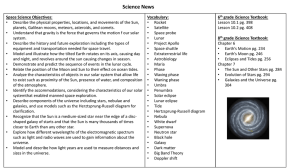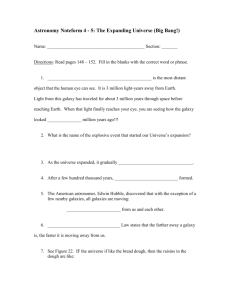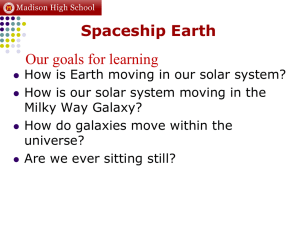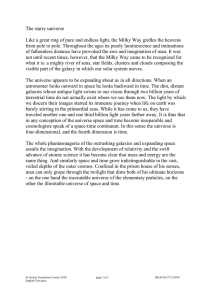Introduction to the Universe
advertisement
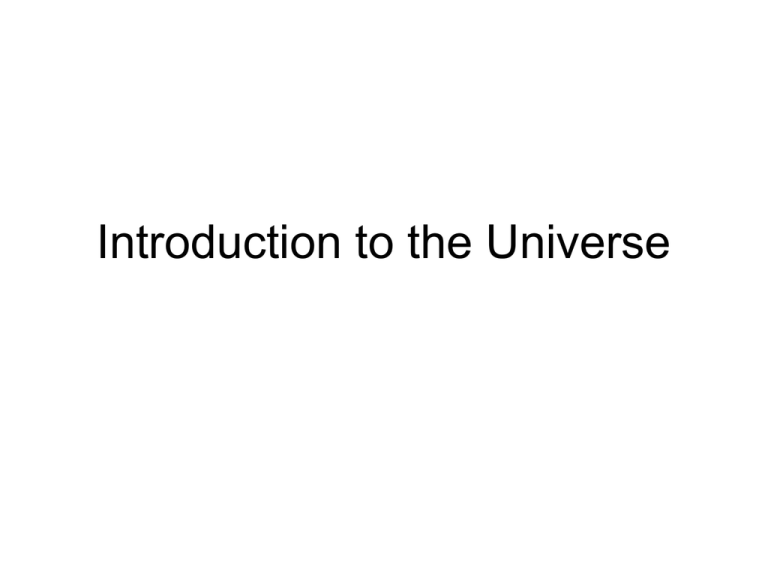
Introduction to the Universe Related Goals • Appreciating science in general, and astronomy in specific. • Understanding how knowledge is gained and be critical of what you see and hear. You will begin to ask “How can we test that?” when forming hypotheses or “How do we know that?” when reading new information. • Developing a working knowledge of the scientific method and how to apply it to real world situations. • Critically analyzing and evaluating information, scientific or otherwise Related Outcomes • Learn some simple astronomical nomenclature/terminology • Learn about some problems astronomers and astrophysicists are trying to solve, and understand the methods scientists are using to try to solve these problems. • Develop a sense of what scientists know about the overall universe, its constituents, and our location Astro 25 extra outcomes that we’ll touch on in chapter 1 • Understand the data that led to the development of modern cosmology and the Big Bang theory • Evaluate the significance of the major evidence in favor of the Big Bang theory. • Illustrate how galaxies are distributed through space. • Discuss the evidence for Dark Matter and Dark Energy. Topics in this presentation • • • • Astronomical numbers Light travel time Composition of universe Why the composition changes – What causes the change? • Sizes, distances, and ages • Motions • Expanding universe, how we measure age Astronomical numbers • 1 million = _________ = 10_. 1 million sec = ________ • 1 billion = __________= 10_ (aka. Giga or G). 1 giga-sec = – _____________. • • • • • • 1 light sec = ________________________________ = _________ = _____________. Almost to ________ 1 light year = _______________________________ TRIVIA: 1 light year = ____________________. Nearest star to Sun = _______________ away. The Sun, all 8 planets are about _________ old. – How many years is that? • Universe & everything in it is _________ (some things weren’t born at the beginning, so are younger) Calif. School Science Standards for Earth’s age & life development • From California Science Standards, grade 6 – – • Students know that evidence from geologic layers and radioactive dating indicates Earth is approximately 4.6 billion years old and that life on this planet has existed for more than 3 billion years. Newest evidence: life probably started 3.5 billion years ago, maybe even earlier (4 Gyr?). And from the high school standards: – Students know the evidence from Earth and moon rocks indicates that the solar system was formed from a nebular cloud of dust and gas approximately 4.6 billion years ago. • The standards should include evidence from meteorites (space rocks that landed on Earth) Astronomers can detect a galaxy that is 10 billion light-years away. 1. True 2. False 0 0 1 2 3 4 5 6 7 8 9 10 11 12 13 14 15 16 17 18 19 20 21 22 23 24 25 26 27 28 29 30 31 32 33 34 35 36 37 38 39 40 41 42 43 44 45 46 47 48 49 50 51 52 53 54 55 56 57 58 59 60 61 62 63 64 65 66 67 68 69 70 71 72 73 74 75 76 77 78 79 80 Finding baby & senior citizen galaxies Talk to your neighbor for 1 minute and answer these: • Where would astronomers need to look to find galaxies in their earliest stages of life (babies)? • Where would we find galaxies in their later stages (senior citizens)? Light years and observations • FOR MORE HELP: • See figure 1.5 on p. 9 • Lecture Tutorial workbook “Looking at Distant Objects,” page 131. California Elementary School Science Standards for atoms • From California Science Standards, grade 5 – Students know that each element is made of one kind of atom and that the elements are organized in the periodic table by their chemical properties. Composition of the Universe • Stuff in universe (“______”) • _______ matter ______________ ______________ – _______ (often ____) ~___% – _______ (often inert ____) ~__% – ________________________ • __________________________________ __________________________________ • ______________________ are _________. • __________________ – Matter ___________. Infer its existence many ways. ______________________ • _____________________ – Energy ___________. Infer its existence by _____________________________ _______. Book OMITS this from chap 1. Another visual of universe’s composition Composition of the Universe 0.6% 4.4% 22% Dark Energy Dark Matter "Normal Stuff" (baryons) Neutrinos 73% Normal matter • Everything you know about is made of a few ______________________ – __________________________________________ • Most things are _______________________ – _______________________________________ • Science tells us right after the Big Bang, the universe ________________________: – ______________________________________ – TINY bit of 1-2 more. • Where did everything else come from? • Book calls it “_________”. See pages 6-7. • Only __________________________. But that’s enough to ______________________, luckily. Calif. Elementary School Science Standards for atoms & compounds • From California Science Standards, grade 8 – – • Students know the structure of the atom and know it is composed of protons, neutrons, and electrons. Students know that compounds are formed by combining two or more different elements and that compounds have properties that are different from their constituent elements. And from the high school standards: – Students know the evidence indicating that all elements with an atomic number greater than that of lithium have been formed by nuclear fusion in stars. Ages of a few things • When things formed: – The Big Bang = ____________________ ago – The Sun & Earth = ________________ ago – The Milky Way galaxy = _____________ years ago • See the calendar & discussion on page 14. Sizes & Distances • Planet order & sizes with hands… • In the “Voyage” scale model, __________ – Sun is the size of ___________________ – ____________________________________ ____________________________________ – ____________________________________ ____________________________________ – Jupiter is … – Pluto is … – Nearest star is named …, size & dist … – Size of Milky Way is … • Light travel times to these objects… California Elementary School Science Standards for solar system • From California Science Standards, grade 5 – Students know the Sun, an average star, is the central and largest body in the solar system and is composed primarily of hydrogen and helium. – Students know the solar system includes the planet Earth, the Moon, the Sun, eight other planets and their satellites, and smaller objects, such as asteroids and comets. • Satellites = moons California Elementary School Science Standards for solar system • And from the high school standards: – – – – Students know the evidence indicating that the planets are much closer to Earth than the stars are. Students know the Sun is a typical star and is powered by nuclear reactions, primarily the fusion of hydrogen to form helium. Students know the solar system is located in an outer edge of the disc-shaped Milky Way galaxy, which spans 100,000 light years. Students know galaxies are made of billions of stars and comprise most of the visible mass of the universe. • Not true anymore. Most visible mass seems to be located in the center of galaxy clusters. Motions • Daily motion – Earth’s rotation once per __ – Speed varies: ___ for Santa, __________________ • Yearly motion – Earth’s revolution once per __ – Distance: 1AU = ____ – Speed: average ~_____________mph – Direction ________________________________. • Sun ___________________________ 230 Myr – 28,000 ly radius, speed ~500,000 mph – Studying this motion ______________________ • Galaxies moving relative to each other. – _________________________________________ Do all continents on Earth take 24 hours to make one circle around the Earth? 1. Yes 2. No 0 0 1 2 3 4 5 6 7 8 9 10 11 12 13 14 15 16 17 18 19 20 21 22 23 24 25 26 27 28 29 30 31 32 33 34 35 36 37 38 39 40 41 42 43 44 45 46 47 48 49 50 51 52 53 54 55 56 57 58 59 60 61 62 63 64 65 66 67 68 69 70 71 72 73 74 75 76 77 78 79 80 Galaxies outside the Local Group are moving: 1. Towards us 2. Away from us 3. Randomly towards & away 0 0 0 1 2 3 4 5 6 7 8 9 10 11 12 13 14 15 16 17 18 19 20 21 22 23 24 25 26 27 28 29 30 31 32 33 34 35 36 37 38 39 40 41 42 43 44 45 46 47 48 49 50 51 52 53 54 55 56 57 58 59 60 61 62 63 64 65 66 67 68 69 70 71 72 73 74 75 76 77 78 79 80 Expanding universe means “objects are getting _________”? 1. Further apart 2. Bigger 3. Both further apart and bigger 0 0 0 1 2 3 4 5 6 7 8 9 10 11 12 13 14 15 16 17 18 19 20 21 22 23 24 25 26 27 28 29 30 31 32 33 34 35 36 37 38 39 40 41 42 43 44 45 46 47 48 49 50 51 52 53 54 55 56 57 58 59 60 61 62 63 64 65 66 67 68 69 70 71 72 73 74 75 76 77 78 79 80 Expanding universe • Expansion refers to __________________________ – Objects don’t grow because … • ___________________________________________ – Examples: ______________________________________. • We see _______________________ • Speed away from us depends on ______________ – Objects ____________ are moving twice as fast – Objects _____________ are moving _________________ • This rule is now called “____________________” • Let’s see how __________________ works with cars Car “expanding universe” • Make a chart like the one I put on the board (next slide has room) • Car 1 is 60 miles away and travels 30 mph • Car 2 is 120 miles away. How fast is it moving if it follows Hubble’s Law? • Car 3 is 240 miles away. How fast? • How long since Car 1 left you? • Car 2? • Car 3? • How old is the “car universe?” • This is exactly what we see with galaxies, except the time is _________ years. Chart goes here California Elementary School Science Standards for astronomy • From California Science Standards, grade 8 – – – – Students know galaxies are clusters of billions of stars and may have different shapes. Students know that the Sun is one of many stars in the Milky Way galaxy and that stars may differ in size, temperature, and color. Students know how to use astronomical units and light years as measures of distances between the Sun, stars, and Earth. Students know that stars are the source of light for all bright objects in outer space and that the Moon and planets shine by reflected sunlight, not by their own light. • – (technically, Moon & planets shine by scattered light) Students know the appearance, general composition, relative position and size, and motion of objects in the solar system, including planets, planetary satellites, comets, and asteroids. Summary – chapter 1 • • • • Astronomical numbers Light travel time Composition of universe Why the composition changes – What causes the change? • Sizes, distances, and ages • Motions • Expanding universe, how we measure age
